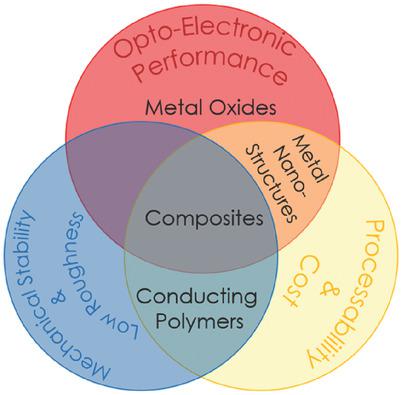当前位置:
X-MOL 学术
›
Adv. Electron. Mater.
›
论文详情
Our official English website, www.x-mol.net, welcomes your feedback! (Note: you will need to create a separate account there.)
Materials for Transparent Electrodes: From Metal Oxides to Organic Alternatives
Advanced Electronic Materials ( IF 6.2 ) Pub Date : 2018-01-19 , DOI: 10.1002/aelm.201700412 Anna Isabel Hofmann 1, 2 , Eric Cloutet 1 , Georges Hadziioannou 1
Advanced Electronic Materials ( IF 6.2 ) Pub Date : 2018-01-19 , DOI: 10.1002/aelm.201700412 Anna Isabel Hofmann 1, 2 , Eric Cloutet 1 , Georges Hadziioannou 1
Affiliation

|
Optoelectronic devices, such as displays, are now omnipresent in our daily life. A crucial component of these devices is a transparent electrode, which allows the in‐ and outcoupling of light. With the goal of optimizing the electrode characteristics and improving device efficiencies, many approaches for the fabrication of thin, transparent, conducting films have been studied. This review gives an overview of the different material classes which are used as transparent electrodes, ranging from metal oxides, such as indium tin oxide, metal, and carbonaceous nanostructures, to conducting polymers and composites. For every material class, a brief description of the fundamental principles, processing routes, and the latest achievements is given. Furthermore, the optoelectronic performance, flexibility, and surface roughness of the different electrodes are compared. Ultimately, advantages and drawbacks of the respective electrodes are discussed. This critical comparison of fundamentally different transparent conducting materials allows, on one hand, to make a sensible choice of electrode for specific applications, and, on the other hand, to point out scientific challenges that must still be addressed.
中文翻译:

透明电极材料:从金属氧化物到有机替代物
诸如显示器之类的光电设备现在已经在我们的日常生活中无处不在。这些设备的关键组成部分是透明电极,它允许光的输入和输出耦合。为了优化电极特性并提高器件效率,已经研究了许多制造薄的,透明的导电膜的方法。这篇综述概述了用作透明电极的不同材料类别,从金属氧化物(例如铟锡氧化物,金属和碳质纳米结构)到导电聚合物和复合材料,不一而足。对于每种材料类别,都简要描述了基本原理,加工路线和最新成果。此外,光电性能,灵活性,比较不同电极的表面粗糙度。最终,讨论了各个电极的优缺点。根本不同的透明导电材料的这种严格的比较,一方面允许针对特定应用做出明智的电极选择,另一方面,指出必须解决的科学挑战。
更新日期:2018-01-19
中文翻译:

透明电极材料:从金属氧化物到有机替代物
诸如显示器之类的光电设备现在已经在我们的日常生活中无处不在。这些设备的关键组成部分是透明电极,它允许光的输入和输出耦合。为了优化电极特性并提高器件效率,已经研究了许多制造薄的,透明的导电膜的方法。这篇综述概述了用作透明电极的不同材料类别,从金属氧化物(例如铟锡氧化物,金属和碳质纳米结构)到导电聚合物和复合材料,不一而足。对于每种材料类别,都简要描述了基本原理,加工路线和最新成果。此外,光电性能,灵活性,比较不同电极的表面粗糙度。最终,讨论了各个电极的优缺点。根本不同的透明导电材料的这种严格的比较,一方面允许针对特定应用做出明智的电极选择,另一方面,指出必须解决的科学挑战。



























 京公网安备 11010802027423号
京公网安备 11010802027423号